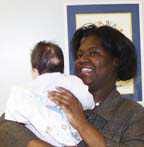“So many terrible things have happened to them,” said First Lady Sandra Cunningham as she held Julie, a five-month-old baby girl, on Thursday. “Thank God they have place to come.”
Julie, who lives at the infant care center Hudson Cradle, is a “boarder baby.” She is healthy enough to be discharged from a hospital but does not have a family who is willing or able to take care of her needs.
Many boarder babies have been drug-exposed or HIV-exposed, according to Sallie Porter, executive director of Hudson Cradle in Jersey City. Licensed to have seven infants at a time, the two-story house adjacent to the Greenville Hospital has cared for 355 babies since it opened in 1992. Board members, nurses, and politicians celebrated the infant care center’s 10th anniversary Thursday. The center’s first baby, Connie, is now nine years old and living with her family in Jersey City.
Dr. Jonathan Metsch saw a need for a place like Hudson Cradle in 1991 when he first joined Liberty Health Care System as its CEO. Upon learning that nearly 40 babies in a nursery without windows had been retained indoors for up until a year because the hospital did not have the insurance nor the resources to care for them otherwise, Metsch began forming a group to care for these babies in a more nurturing manner.
“Everyone should make time to help someone out,” Metsch said of his volunteerism. “And this is the easiest way to do it, because everyone likes babies.”
Rather than stay in the confines of a hospital nursery, the boarder babies reside in a more domestic setting where each room has three cribs, sunlight, and lots of toys. Metsch recalled the first time he brought his mother to Hudson Cradle. “She sat here and cradled the babies in a rocking chair,” Metsch said. “She has been knitting booties for them ever since.”
Going to homes
About 15 percent of the babies go home with their parents, and the others find foster homes that often turn into adoptions. Porter estimates that most babies remain in the facility for an average of two months, where round-the-clock nurses tend to the health needs of each baby, and take them for strolls outside.
Porter, a pediatric nurse who has worked for Hudson Cradle since its inception, said the job has always been fulfilling. “When they arrive, they’re small and uncomfortable,” Porter said. “And then, in a few weeks, they really start to flourish. That’s really rewarding.”
More than simply housing babies, Hudson Cradle provides a top-to-bottom care center for children in crisis who can be steered toward a healthy life with infant care. The children at Hudson Cradle receive child care, nursing, nutritional services, early intervention, developmental evaluation and intervention, infant massage, care coordination and transportation. Foster parents and blood-related parents also learn how to manage the different problems that the infants might have.
In addition to the on-staff nurses, volunteers from the community enter Hudson Cradle at scheduled times and care for the babies by simply giving them the love and attention infants need at that age. “They usually play with the babies and hold them,” Porter said.
Volunteers must fill out an application at the 1805 Kennedy Blvd. address, and complete a program.
Raising dollars
While Porter would like to see the center expand its ability to care for more babies, Hudson Cradle has a hard time raising the required funds to run the facility as it is. Although Hudson Cradle has consistently served boarder babies for a decade, each year, the organization works hard to raise enough money to pay the operating expenses, said Scott Harwood, president of the board.
“I like developing new programs,” Metsch said. “What I didn’t realize is that you have to raise money for them.” Metsch, who once served as president of the board, invited Harwood of Harwood Properties to visit Hudson Cradle in 1996, and managed to pique his interest in the program. Starting with a banquet in the library of Hudson County Community College that raised $40,000, Harwood has been diligently organizing fundraising events ever since.
According to Harwood, 95 percent of the $650,000 annual budget goes to operating costs, leaving very little for any future expansion.
Despite the successful track record, Harwood said that it is always an uphill battle. In 1997, federal funding for the program was scaled back dramatically, leaving a $350,000 gap. In 1999, the organization managed to get an amount equal to that in state grants. But in light of the state’s present budget gap, Harwood fears that this year’s grant might be less than usual.
The big annual fundraiser for Hudson Cradle, Taste of the Hudson, will be held on April 18 at the Harborside Atrium.
For more information about Hudson Cradle’s volunteer program or fundraisers, call (201) 332-7879.
